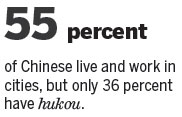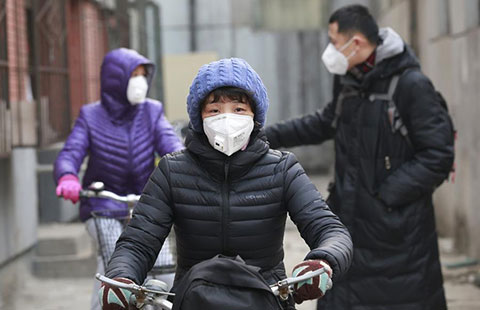Rules drawn for migrant integration
Updated: 2015-12-23 07:56
By Zheng Yangpeng(China Daily)
|
||||||||
New approach offers incentives for local governments to proceed with assimilation
China's top economic planner is drawing up a document outlining a new style of urbanization that offers incentives for local governments to integrate migrant workers.
Xu Shaoshi, minister of the National Development and Reform Commission, said at an annual conference on Tuesday that the plan, which consists of 36 articles, has been submitted to the State Council for its opinion.
Specifically, Beijing will link the number of migrant workers a local government assimilates to three treasured quotas: the central government's transfer payments to local governments, additional urban construction land and construction funding.
"The design was proposed in early 2014, in the Blueprint for New-Style Urbanization, but it lacked implementation details. If implemented, it could offer powerful impetus, as these quotas are always in short supply," said Ni Pengfei, head of the Center for City and Competitiveness at the Chinese Academy of Social Sciences.
Transfer payments are a key revenue source for local governments, contributing 30 percent of money in 2014 - possibly higher in underdeveloped regions. Urban construction land is increasingly scarce in major cities.
Xu's comment came at the end of the Central Urban Work Conference, the first in 37 years. The conference is expected to develop policies ranging from city planning, housing, city population, infrastructure and public administration for years to come.

Xu said the document integrates guidance from the conference, adding that the gathering's main goal was to build "harmonious, livable, vibrant and distinctive" modern cities.
The recently concluded Central Economic Work Conference highlighted the issue of absorbing migrants as a new source of demand in the Chinese economy. Hopes have been pinned on migrants as a solution for dissolving the country's glut of unsold homes.
By 2014, about 55 percent of China's population lived and worked in cities, but those with urban household registration, or hukou, accounted for only 36 percent of total. The rest were migrants. Without urban hukou, 274 million of Chinese are denied access to education, employment and healthcare services.
Signaling lower GDP growth next year, Xu said the country faces an "even more complicated and grim" situation in 2016.
zhengyangpeng@chinadaily.com.cn
(China Daily 12/23/2015 page4)

 Whatever the shape or size of a tree, Merry Christmas!
Whatever the shape or size of a tree, Merry Christmas!
 The world in photos: Dec 14 - 20
The world in photos: Dec 14 - 20
 First American woman who works as captain for a Chinese airline
First American woman who works as captain for a Chinese airline
 Life of a family amid Beijing's red alert smog
Life of a family amid Beijing's red alert smog
 External coffin lid of 2,000-year-old Chinese tomb opened
External coffin lid of 2,000-year-old Chinese tomb opened
 First Miss Iraq named in decades
First Miss Iraq named in decades
 Iraq holds its first beauty contest in 40 years
Iraq holds its first beauty contest in 40 years
 Highlights at the Light of the Internet Expo
Highlights at the Light of the Internet Expo
Most Viewed
Editor's Picks

|

|

|

|

|

|
Today's Top News
Shooting rampage at US social services agency leaves 14 dead
Chinese bargain hunters are changing the retail game
Chinese president arrives in Turkey for G20 summit
Islamic State claims responsibility for Paris attacks
Obama, Netanyahu at White House seek to mend US-Israel ties
China, not Canada, is top US trade partner
Tu first Chinese to win Nobel Prize in Medicine
Huntsman says Sino-US relationship needs common goals
US Weekly

|

|








